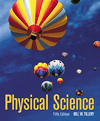 |
1 |  | 
An electron with a mass of 9.11 x 10-31 kg has a velocity of 4.3 x 106 m/s in the innermost orbit of a hydrogen atom. What is the de Broglie wavelength of the electron? |
|  | |
 |
 |
2 |  | 
Calculate the energy
(a) in eV and
(b) in joules of the third energy level (n = 3) of a hydrogen atom. |
|  | |
 |
 |
3 |  | 
How much energy is needed to move an electron in a hydrogen atom from the ground state (n = 1) to n = 3? Give the answer
(a) in joules and
(b) in eV. |
|  | |
 |
 |
4 |  | 
What frequency of light is emitted when an electron in a hydrogen atom jumps from n = 2 to the ground state (n = 1)? |
|  | |
 |
 |
5 |  | 
How much energy is needed to completely remove an electron from n = 2 in a hydrogen atom? |
|  | |
 |
 |
6 |  | 
If the charge-to-mass ratio of a proton is 9.58 x 107 coulomb/kilogram and the charge is 1.60 x 10-19 coulomb, what is the mass of the proton? |
|  | |
 |
 |
7 |  | 
An electron wave making a standing wave in a hydrogen atom has a wavelength of 8.33 x 10-11 m. If the mass of the electron is 9.11 x 10-31 kg, what is the velocity of the electron according to the de Broglie equation? |
|  | |
 |
 |
8 |  | 
Using any reference you wish, write the complete electron configurations for
(a) nitrogen,
(b) phosphorus, and
(c) chlorine. |
|  | |
 |
 |
9 |  | 
Explain how you know that you have the correct total number of electrons in your answers for 8a, 8b, and 8c. |
|  | |
 |
 |
10 |  | 
Referring to Figure 9.21 only, write the complete electron configuration for
(a)neon,
(b) sulfur, and
(c) calcium. |
|  | |
 |



 2002 McGraw-Hill Higher Education
2002 McGraw-Hill Higher Education

 2002 McGraw-Hill Higher Education
2002 McGraw-Hill Higher Education